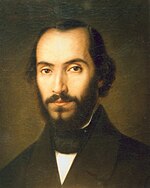art.wikisort.org - Artist
Gheorghe Tattarescu (Romanian pronunciation: [ˈɡe̯orɡe tataˈresku]; October 1818 – October 24, 1894) was a Moldavian, later Romanian painter and a pioneer of neoclassicism in his country's modern painting.
This article may be expanded with text translated from the corresponding article in Romanian. (November 2022) Click [show] for important translation instructions.
|
Gheorghe Tattarescu | |
|---|---|
 Self-portrait (1849) | |
| Born | October, 1818 Focşani |
| Died | October 24, 1894 Bucharest |
| Nationality | Romanian |
| Known for | Painting, mural |
| Movement | Neoclassicism |
Biography
Early life and studies
Tattarescu was born in Focşani in 1818. He began as an apprentice to his uncle Nicolae Teodorescu, a church painter. He studied at the Painting School from Buzău, when Teodorescu moved there. The Orthodox Bishop of Buzău, Chesarie Căpățână, helped him obtain a scholarship in Rome, where he was taught by professors from the Accademia di San Luca. While there, Tattarescu made copies of paintings by Raphael, Bartolomé Estéban Murillo, Salvatore Rosa, and Guido Reni.
Political activities


Tattarescu was a participant in the 1848 Revolution in Wallachia. After the revolution, he painted portraits of Romanian revolutionaries in exile such as Gheorghe Magheru, Ştefan Golescu, and, in 1851, that of Nicolae Bălcescu (in three almost identical versions). Romantic nationalist ideals were the inspiration for his allegorical compositions with revolutionary themes in Romania's rebirth (1849), the patriotic Principalities' Unification (1857) and February 11 - The Modern Romania (1866).[1]
Later life and legacy
In 1860, being commissioned to draw up a National Album of sights and historical monuments of the country, his talent of painting vaguely Romantic landscapes became highly valued. At the same time, showing his sympathy with various peasant uprisings, he painted The peasant at the Danube in 1875. He was also commissioned to decorate several churches in a neoclassical manner.
In 1864, together with painter Theodor Aman, Tattarescu founded the The National School of Fine Arts in Bucharest. He was a professor there for a long time after, and served as the School's Director for two years (1891–1892).
In 1865, he wrote Useful Principles and Studies on Proportions of the Human Body and Drawing after the Most Famous Painters.
Tattarescu died in Bucharest. The house he bought in 1855 and lived in for almost 40 years is now home to the Gheorghe Tattarescu Memorial Museum. It was opened 1951, and hosts several of his original works of art.
Gallery
Click on an image to view it enlarged.
- Old monk
- Painter's wife and his son
- Pilgrim
- Portrait of Ion Grădişteanu
- Portrait of Maria Grădişteanu
- Landscape from Italy
- Dâmbovicioara cave
See also
- Metropolitan Cathedral, Iaşi
Notes
- Voinescu, p. 46-47
References
- Voinescu, Teodora, Gheorghe Tattarescu 1818-1894, Ed. Academiei Romane, 1940.
External links
- (in English) Biography at artnet.com
- (in French) Biography at maroumanie.com
- (in Romanian) Biography at ici.ro
- (in Romanian) Biography at compendium.ro
На других языках
- [en] Gheorghe Tattarescu
[fr] Gheorghe Tattarescu
Gheorghe Tattarescu, né à Focșani en octobre 1818 et mort à Bucarest le 24 octobre 1894, est un peintre roumain de style néoclassique, de la période de la renaissance culturelle roumaine.[it] Gheorghe Tattarescu
Gheorghe Tattarescu (Focșani, ottobre 1818 – Bucarest, 24 ottobre 1894) è stato un pittore rumeno, legato alla corrente artistica del Neoclassicismo.[ru] Таттареску, Георге
Георге Таттареску (рум. Gheorghe Tattarescu; 1 октября 1818 (1818-10-01), Фокшаны — 24 октября 1894, Бухарест) — румынский художник, один из основоположников неоклассицизма в этой стране.Другой контент может иметь иную лицензию. Перед использованием материалов сайта WikiSort.org внимательно изучите правила лицензирования конкретных элементов наполнения сайта.
WikiSort.org - проект по пересортировке и дополнению контента Википедии






